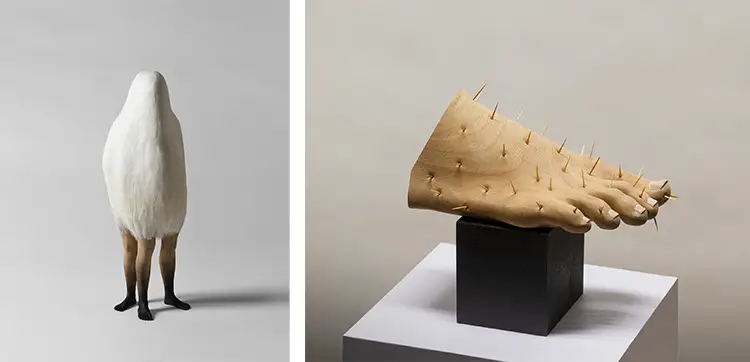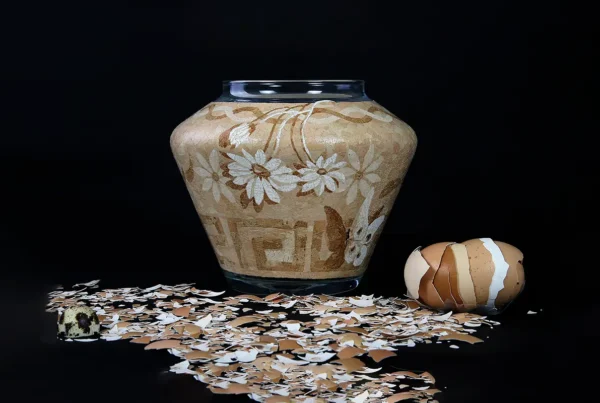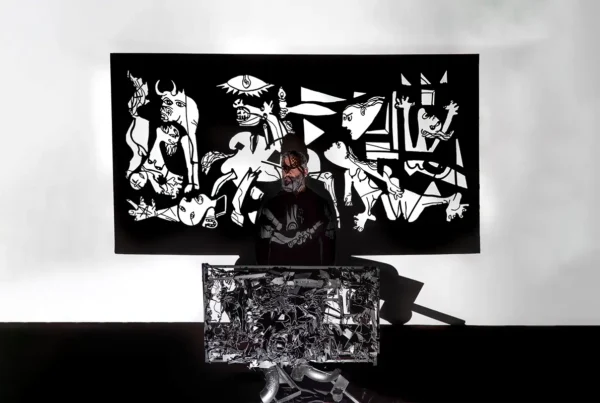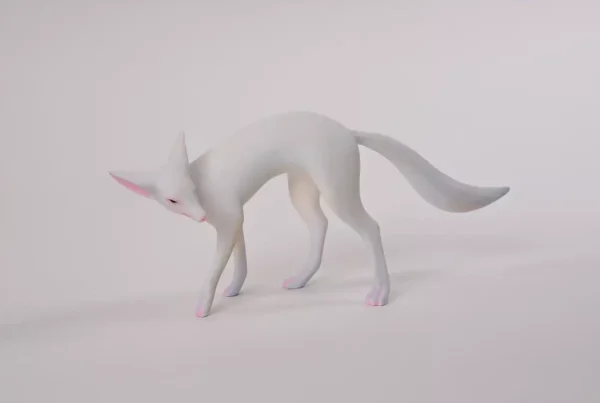Rooted in Memory, Shaped by Time
Andreas Senoner’s sculptures do not simply occupy space—they summon it into dialogue. Born in 1982 in the alpine city of Bolzano in northern Italy, Senoner’s early exposure to the layered natural and cultural textures of the region continues to echo through his work. Now based in Florence, he channels the atmospheric contrasts between mountainous terrain and artistic heritage into his sculptural language. Wood, his material of choice, isn’t just a surface to carve but a conduit through which stories of transformation, identity, and memory are channeled. Every knot, grain, and crack becomes a line in a larger narrative that binds the physical to the emotional, the historical to the contemporary.
His academic path has mirrored his multifaceted approach to sculpture. After gaining foundational training at the Academy of Fine Arts in Florence, Senoner expanded his sensibilities at the Facultad de Bellas Artes San Carlos in Valencia. There, under the guidance of experimental artist Bartolomé Ferrando, he encountered the possibilities of sound, performance, and conceptual art—tools that would later sharpen the emotional and symbolic range of his practice. The turning point came in 2006 with a scholarship to the Minneapolis College of Art and Design, where sculptor Kinji Akagawa’s nuanced approach to space and material offered a deeper path into wood carving. This experience did more than refine technique—it anchored Senoner’s relationship with wood as a primary vehicle for expressive thought.
Wood, in his hands, is more than a medium. It becomes a collaborator in the creative process. For Senoner, the organic qualities of wood—its cellular memory, its visible history encoded in rings and textures—mirror the human experience of change and growth. Carving into it is an act of conversation rather than domination, where the resulting form is as much a response to the material’s past as it is to the artist’s intent. It’s a metaphor made tangible: memory is both stored and reshaped, inherited yet mutable. This fundamental belief in material vitality lies at the heart of his evolving exploration into transformation and hybridity.
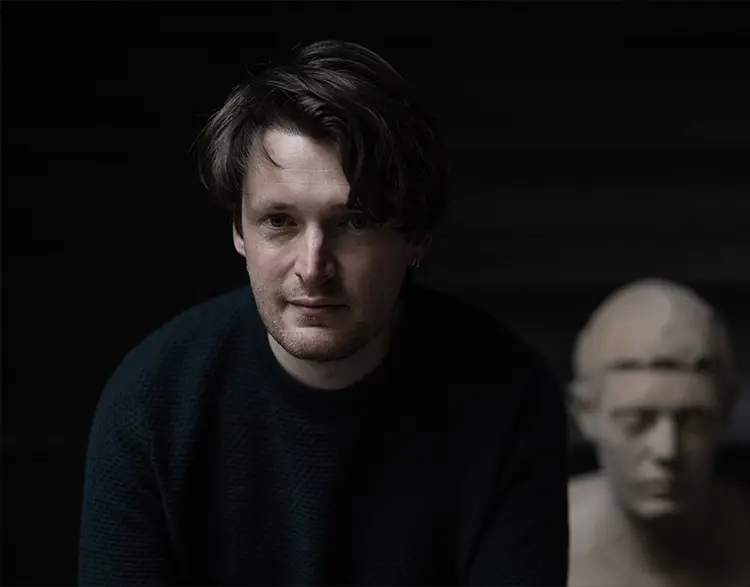
Andreas Senoner: Echoes of Transformation
Senoner’s work is steeped in the idea that identity is not fixed, but always becoming. Metamorphosis, as he defines it, captures the shifts that define human experience—emotional, physical, and psychological transitions that quietly reconfigure who we are. His sculptures often feature hybrid forms, caught mid-transformation, suspended in a liminal space between what was and what might be. These figures are not grotesque distortions, but nuanced portrayals of becoming: a child-like body cloaked in feathers, or a form that resists easy classification. They reflect the thresholds of change—moments when we are no longer who we were, but have not yet arrived at our next version.
Stratification—a layering of materials, histories, and meanings—is equally central to his aesthetic. The sculptures suggest time not as a linear progression, but as sediment: compacted memory, biology, and culture in tangible form. In this sense, the body in his work becomes an archive, one that resists simplification. Each layer tells of past experiences, emotional weights, and generational inheritances. These layers are sometimes literal, composed of wood interlaced with other organic matter, and sometimes symbolic, inviting viewers to trace the invisible lines between personal memory and collective heritage.
Senoner’s 2017 Heritage series marked a significant deepening of these explorations. Through sculpted self-portraits, he examined the confluence of personal history and broader cultural frameworks. Rather than focusing on likeness, these works scrutinize how memory etches itself onto the self, how internal transformations find expression through material form. By embedding his own image into the artwork, he opened a reflective space that blurs the personal with the universal. Viewers are invited not merely to observe but to insert their own memories into the sculptural strata, transforming the object into a shared psychological space.
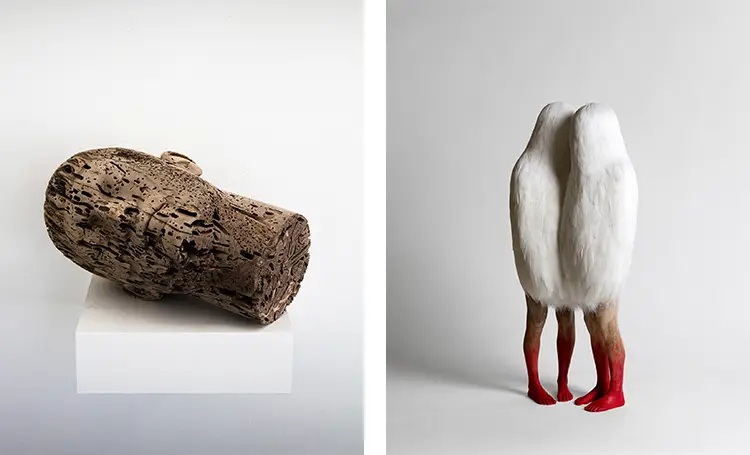
Organic Language, Symbolic Matter
While wood remains his core medium, Senoner’s sculptures are enhanced by an ensemble of organic materials, each chosen for its narrative charge and biological origin. Feathers, lichens, beeswax, and fabrics serve not as adornment but as conceptual tools, expanding the meaning of each piece. A feather might suggest both ascension and disguise, while beeswax speaks to labor, warmth, and preservation. These elements add layers of sensory and symbolic resonance, enriching the emotional grammar of his work. They do not distract from the central form—they extend it, drawing the viewer into a more immersive encounter.
Lichens, in particular, appear across multiple works, chosen for their associations with survival, adaptability, and mutual dependence. Growing slowly and often in harsh environments, they mirror the themes of resilience that underpin much of Senoner’s practice. Their inclusion suggests a quiet strength, a resistance to erasure, and a relationship with time that is non-linear and patient. Likewise, fabrics—sometimes subtly integrated—hint at memory through touch and domesticity. They are traces of the human presence that once wore or used them, now embedded into sculptural memory.
This commitment to materials as storytellers also connects to a broader inquiry into ecological awareness and post-humanist perspectives. Senoner’s work does not place the human figure at the center in a classical sense; rather, it questions its stability and autonomy. Hybridity—whether between species, materials, or identities—becomes a way to reimagine what it means to exist in relation to others, both human and non-human. The boundaries between body, object, and environment begin to dissolve, replaced by porous interfaces that suggest a world constantly in flux.
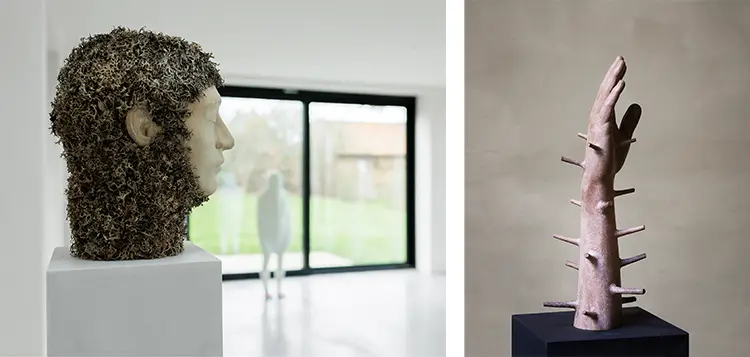
Andreas Senoner: A Silent Dialogue with the Viewer
Senoner constructs his sculptures not as static monuments but as moments of encounter—introspective, elusive, and open-ended. The figures, often suspended in ambiguous gestures or postures, resist immediate comprehension. They beckon the viewer into a quiet, personal dialogue, one shaped more by emotion and memory than by interpretation. This deliberate ambiguity fosters introspection. The sculptures act as mirrors, asking not what they are, but what they stir in us. Their stillness is not emptiness; it is an invitation to feel time, transition, and memory on a visceral level.
His approach to exhibition reflects this philosophy. Displaying work internationally—from Italy to the United States, from Switzerland to France—Senoner remains attentive to how different audiences engage with his forms. Participation in major platforms like the 2011 Venice Biennale offered not just exposure, but confirmation that his exploration of specificity—wood, memory, cultural inheritance—has global resonance. Viewers across geographies find recognition in the emotional terrain his work traverses, proving that deeply personal narratives often carry the widest reach when shaped with care and authenticity.
Looking ahead, Senoner continues to investigate the interplay between personal identity and environmental consciousness. Current projects are beginning to incorporate ecological themes more explicitly, reflecting on how collective memory is embedded in the natural world. Sustainable material sourcing and attention to environmental narratives are becoming increasingly integral to his process. For him, the boundaries between nature and human history are no longer separate spheres—they are sites of entanglement, where sculpture can speak not just of the past or the self, but of shared responsibility and mutual transformation.
